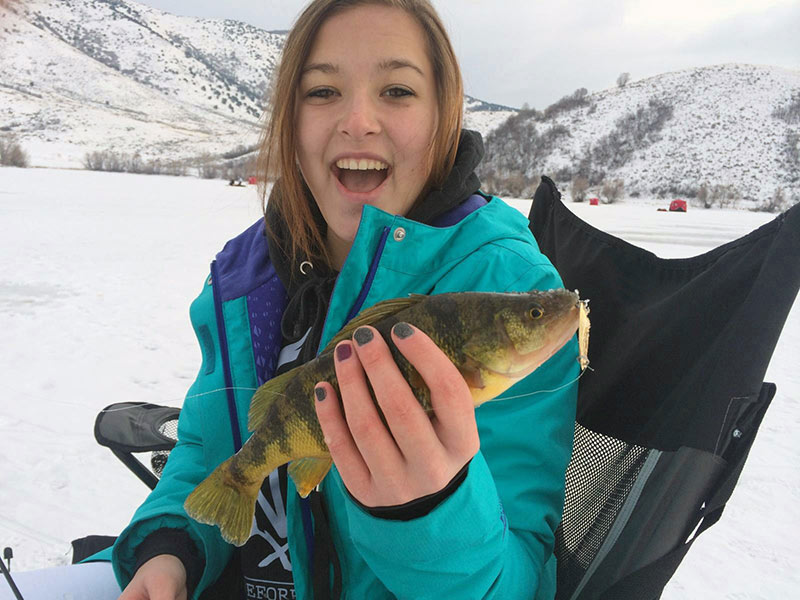4 great waters to ice fish in northern Utah this winter
Ogden — If you're itching to get on the ice to catch fish in northern Utah, the Utah Division of Wildlife Resources has some tips to share. Even if you plan on fishing in other parts of the state, these tips for catching rainbow trout, yellow perch and bluegill should help you put fish on the ice, no matter where you go fishing.
Best Waters
If you want some great ice fishing, you shouldn't let this winter pass without drilling holes and dropping a line at Hyrum, Mantua, East Canyon and Rockport reservoirs.
"Yellow perch fishing is fast at Hyrum and Mantua right now, and bluegill fishing has been great at Mantua too," Chris Penne, DWR northern region aquatics manager, said. "For rainbow trout, try East Canyon or Rockport: Plenty of rainbows — many between 17 to 18 inches long — are available at each water."
Anglers should note that the general safety recommendation is to not step on the ice unless it is at least 4 inches thick. However, keep in mind that ice thickness can vary across a lake, so if you see that it is 4 inches in one spot, don't assume it is 4 inches across the entire lake. Be sure to drill test holes into the ice as you venture onto it. For more ice safety tips, visit the Utah State Parks website.
To find updated fishing conditions, visit the Fish Utah page on the DWR website.
Best spots at each waterbody
Here are some of the best spots at each waterbody to catch fish right now:
Hyrum Lake State Park
The best area to fish right now at Hyrum Reservoir is the eastern part of the reservoir, which can be accessed from the beach area.
"Start in water that's not more than 30 feet deep," Penne said. "If you're not catching fish, try moving a little deeper."
Mantua Reservoir
The best area to fish at Mantua is at the two large bays. One of the bays is on the southeast side of the reservoir (between Maple Creek and the Knoll). The other bay is on the northeast side, between the courtesy dock near the north parking lot and the Knoll.
Anglers should try fishing in water that's 16 to 19 feet deep.
East Canyon State Park
Two spots — the south end (where East Canyon Creek enters the reservoir) and the north end (near the main park facilities and boat ramp) — are good places to try. Start in water that’s not more than 20 feet deep.
If you fish near the inlet, note that the ice near the inlet is probably the thinnest ice on the reservoir, so be cautious and don't fish there if the ice is less than 4 inches thick.
Rockport State Park
The entire reservoir can have good fishing, with the area near the inlet (where the Weber River enters the reservoir) being a popular place to try. Start fishing in water that's between 15 to 20 feet deep.
"If you're not catching fish, they might be shallower or deeper," Penne said. "Move until you find the fish."
Just like at East Canyon, if you fish near the inlet at Rockport, know that the ice near the inlet is probably the thinnest ice on the reservoir.
Trout fishing tips
- Trout move a lot in the winter. For that reason, it's OK to wait as long as 30 minutes before gathering your gear and moving to a different spot.
- Try a 1⁄8-ounce or 1⁄16-ounce jig tipped with a plastic bait. A good brand is the Maniac Custom Lures Cut'r Bug. Various micro plastics from tackle makers such as Clam and Northland Fishing Tackle work well too.
- PowerBait is the perfect bait to place on the jig's hook. Don't glob it on, though. Instead, ball it on so trout can't strip it off the hook. If you'd rather use a worm, both mealworms and wax worms are great worms to use in the winter.
- Trout can be found anywhere in the water column, anywhere from just under the ice to the bottom of the reservoir. For that reason, consider fishing with two rods. Let one of the jigs fall all the way to the bottom, and then reel the jig up about three cranks off the bottom. Then, drill another hole about 10 feet away and suspend the jig on that rod about 4 to 5 feet below the bottom of the ice. Place that rod in a holder that will prevent it from falling into the hole when a trout takes the bait. Stay by the rod with the jig close to the bottom, and also watch the other rod. "This approach allows you to cover two spots in the water column," Penne said. "I've used this approach for years, and it works great."
- It's a good idea to occasionally jig the rig you are sitting by, but sometimes simply letting the jig rest motionless — a technique called deadsticking — will also produce bites. "If you decide to deadstick, use a smaller jig," Penne said. "For example, if you have a 1⁄8-ounce jig and a 1⁄16-ounce jig in your tackle box, use the 1⁄16-ounce jig. Smaller jigs seem to work better for deadsticking."
Yellow perch and bluegill fishing tips
- Unlike rainbow trout, yellow perch and bluegill don't move much in the winter. If you haven't gotten a bite within 15 minutes, move to different spots until you find the fish.
- Perch and bluegill will often bite a little softer in the winter. To know you're getting a bite, use a small ice fishing rod with a light action and a sensitive tip. If your rod doesn't have a light action and a sensitive tip, attach a light wire spring bobber to the end of the rod. The spring bobber will help you detect bites.
- A dropper rig is a great rig to use. To create one, cut 14 to 15 inches off the end of your fishing line and place that piece aside. Then, tie a jig to the end of the line on your rod. After tying the jig, tie the 14- to 15-inch piece you cut earlier to the eyelet on the jig. Finish the rig by tying a small spoon to the end of the piece you cut. This rig will reach the bottom fast, draw the attention of fish and give them two offerings — a jig and a spoon — to go after.
- Tip the lures' hooks with a wax worm or a mealworm. Don't put the whole worm on, though. Instead, tear one end of the wax worm off or break the mealworm in half before threading it on the hook. This will put additional scent in the water that will help attract fish.
- Perch and bluegill are usually on or near the bottom of the reservoir. If you don't have a fish finder (also called a flasher), let your jig fall until it touches the bottom of the reservoir, and then reel it up one to three cranks off the bottom. "If you have a flasher, watch your jig and fish it just slightly off the bottom," Penne said.
- Occasionally jig your rig 1 to 2 inches, and watch your rod tip closely. If the line, the end of your rod or the spring bobber starts to move, set the hook fast and reel your fish in.
- "If you have a flasher and the fish seem hesitant to bite, try reeling your jig slowly off the bottom," Penne said. "Moving your jig slowly, and stopping it occasionally, will often pull fish off the bottom and cause them to strike."

















